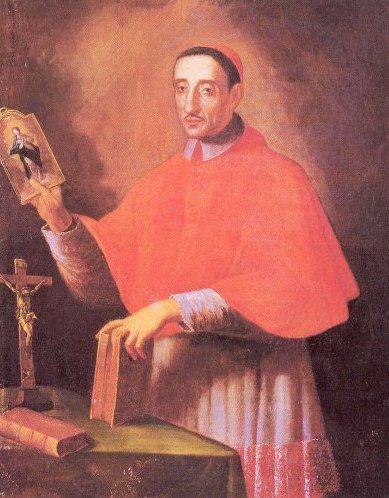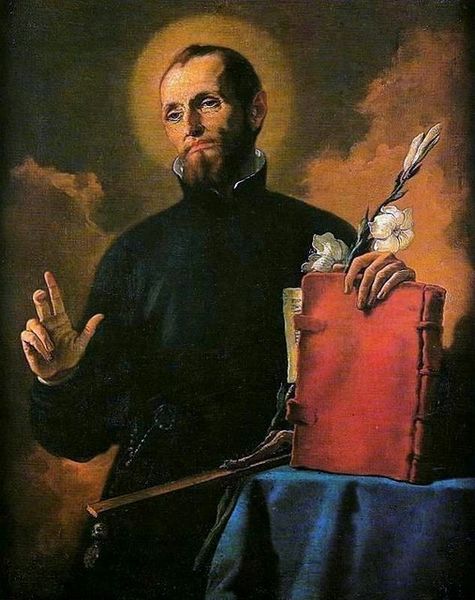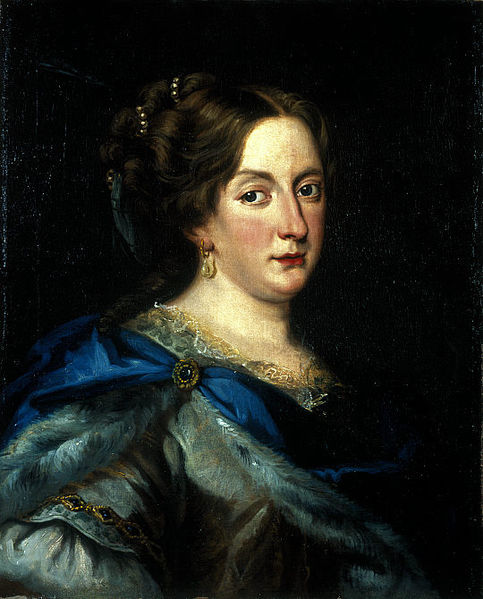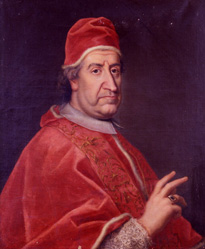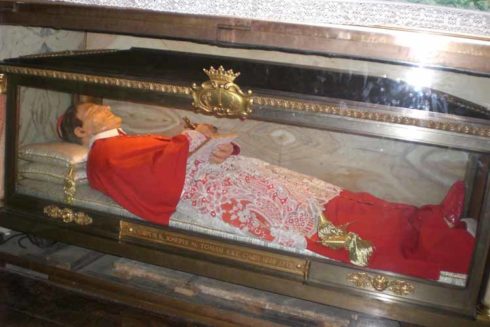Saint Joseph Mary Tomasi
The very eminent servant of God Joseph Mary Tomasi, Cardinal, whom Pope Pius VII decorated with the honors of the Blessed in 1803, and whom today the Supreme Pontiff John Paul II ascribes solemnly in the book of the Saints, was born at Licata, in Sicily, the Diocese of Agrigento, on 12 September 1649, the first son of Julius Tomasi and Rosalie Traina, the Prince of Lampedusa and the Duke of Palma di Montechiaro.
His own life was oriented toward God from his first years. Formed and educated in the noble paternal home, where they did not lack riches nor virtue, he gave proofs of a spirit, very open to study and to piety. His parents cared greatly for this and for his own Christian formation and his instruction in the classical and modern languages, above all in the Spanish language, because he was destined by the family for the court of Madrid, as he was bound to inherit from his own father, for his own noble titles, that of “Grande of Spain”.
But his own spirit aspired, even from youth, to be small in the Kingdom of God, and to serve not the kings of the earth but the King of heaven. He cultivated his pious desire in his heart until he obtained the consent of his father to follow his vocation to the religious life.
After having renounced, by means of a notarial document, the principate, which belonged to him through heredity, and his very rich patrimony, he was admitted into the Order of the Clerics Regular Theatine, founded by St. Cajetan of Thien in 1524. He made his religious profession in the Theatine house of St. Joseph, at Palermo, on 25 March 1666.
In the new state of life, which he had embraced to follow the call of Christ, he was able to dedicate himself better to piety and study. The sacred Liturgy had been his attraction from childhood; even as a child he wanted to wear every day the clothes of the liturgical color of the day. Gregorian chant had blossomed soon on his lips, which exulted with joy singing the liturgical psalms. The sacred languages of Latin and Greek, as if by an innate disposition,
he knew well and appreciated from his adolescence.
He completed his studies of philosophy in Messina, Ferrara, Bologna and Modena, forced to the transfers for reasons of health. He studied Theology instead at Rome, in the House of San Andrea della Valle.
In Rome, after having received the subdiaconate and the diaconate, on the Saturday of Advent, on 23 December 1673, he was ordained a Priest in the Lateran Basilica, at the hands of Mons. Joachim De Angelis, Archbishop of Urbino, Vice-Regent of the Cardinal Vicar Gaspar Carpegna. Two days later, on the night of the Nativity, he celebrated his first Mass, in the church of San Silvestro al Quirinale, at that time the residence of the General House of the Theatine Fathers.
The priestly anointing seems to have incardinated Father Tomasi to Rome and to give him Roman citizenship. Here, from his priestly ordination and in the same house of San Silvestro al Quirnale, for almost forty years, he dedicated himself, with intense productivity, to piety and to assiduous studies. To his knowledge of Latin and Greek, acquired from adolescence, he added that of Hebrew, Syriac, Chaldean and Arabic.
Urged by his particular love for the ancient documents of the Church and for the sound ecclesiastical traditions, he considered that a good part of his own religious perfection lay in dedicating himself, with the spirit of faith, to the publication of rare liturgical books and of the ancient texts of the sacred Liturgy, and so bringing to light many ancient sacred scriptures which until then had been hidden in the libraries.
In fact, thanks to his wide knowledge of sacred matters, he edited many volumes dealing with biblical, patristic and principally liturgical subjects. With these last it is sufficient to mention: Codices Sacramentorum nongentis annis vetustiores (edited in 1680); the critical edition of the Salterio in its double Roman and Gallican version; the Antifonari and Responsoriali of the Roman Church prepared by St. Gregory the Great (edited in 1686); the critical edition of the Sacra Biblia according to the codes from the fifth century to the eleventh century (published in 1688).
On account of his vast scholarship and his excellent and well-known virtues, Father Joseph M. Tomasi was subject to such fame and esteem that everyone sought and felt honored by his acquaintance and knowledge and his friendship. The Queen of Sweden, Christina Alexandra, wanted him among the members whom she honored among her own circle of scholars; the Roman Academy of Arcadia counted him among its own more illustrious members; the learned Rabbi of the Synagogue of Rome, Moses Cave, who was converted to Catholicism while he taught Father Tomasi Hebrew, considered him his friend and father in the faith.
But the greater the praises which the persons of that time attributed to him, the more he tried to remain hidden, even to the point of publishing, because of his humility, some of his own works under a pseudonym.
Besides being in relationship with important persons and scholars of his own intellectual breadth, he dedicated himself no less to the formation of the simple faithful. For these he composed: Vera norma di glorificare Iddio e di far Orazione secondo la dottrina delle divine Scritture e dei Santi Padri, and also a Breve istruzione del modo di assistere fruttuosamente al Santo sacrificio della Messa, as well as a condensed version of the Psalms selected and prepared for facilitating the prayer of the Christian.
Named General Consultor of his Order by his confreres, out of humility he quickly renounced the appointment, alleging the many other occupations for the appointments which he had already in the Roman Curia, among which were those of Consultor of the Sacred Congregations of Rites, and of Indulgences, as well as that of Qualificator of the Holy Office.
His many publications on liturgical subjects, in which piety was united with scholarship, motivated the titles which some of his contemporaries gave to him, those of “the Prince of the Roman Liturgists” and of “Liturgists” and of “Liturgical Doctor”.
All his labors and solicitudes, in research and in his studies, were not able in the slightest amount to distract Father Tomasi from aiming, constantly and with all his strength, at the attainment of that evangelical perfection to which God had called him from his infancy.
To all he was an example of profound humility, of the spirit of mortification and of sacrifice, of faithful observance, of meekness, poverty, piety, and filial devotion to the Blessed Virgin Mary. He helped the poor; he gave relief to the sick, both at home and in the hospital of St. John Lateran. In this way wisdom and charity were united and harmonized in him.
Clement XI, who knew him personally and admired his eminent virtues and the widespread fame of his doctrine, named him cardinal, with the title of Ss. Silvestro e Martino ai Monti, in the Consistory of 18 May 1712. He accepted the cardinalate only through the expressed mandate of the Pope.
Placed in this sublime grade, as a lamp on a lampstand, he illuminated the roman Church to such a point, with the splendor of his virtues, that many venerated him as another St. Charles Borromeo, whom he himself had proposed to imitate.
He joined to the cardinalatial dignity all those virtues which distinguished him as a Theatine religious; he changed none of his previous rule of life. For his court and for the service of his home he chose, for motives of humility, the poor, the weak, the lame and persons with various physical handicaps.
In his titular church of Ss. Silvestro e Martino ai Monti he not only participated, with
the clergy of his family, in the liturgical celebrations of the Carmelite Fathers, but also dedicated himself to teaching the catechism of Christian doctrine to children and to the other faithful.
But such a light of good example and of virtues shone for a short time. Not having completed eight months as a Cardinal, he was struck by a violent pneumonia after he took part, as a member of the Papal chapel, at the vigil of the Nativity in the Vatican Basilica. He died a saintly death on 1 January 1713 in his apartment at the Passarini Palace on the Via Panisperna.
The first panegyric for Cardinal Tomasi was pronounced by the same Pope Clement XI, in the Consistory celebrated one month after his passing. “We cannot disguise”, the Pope said, “the intimate sorrow which the death of eminent and most pious Cardinal Tomasi has provided Us. … He was an authentic model of the most holy and ancient discipline and We already expect much from his virtues and his doctrine”.
The fame of his sanctity that during life accompanied Cardinal Tomasi became even greater immediately after his death. Because of this, only five months from his pious passing, on the desire of Clement XI, the canonical Ordinary Informative Process for his Beatification began. After having overcome vicissitudes and difficulties of various kinds, after two miracles attributed to the intercession of the Venerable Cardinal Tomasi were approved, Pius VII proclaimed him Blessed on 29 September 1803.
A new miracle, attributed to the intercession of Blessed Joseph M. Tomasi, was approved, with the Decree of 6 July 1985, by the Holy Father John Paul 11, for his canonization.
The relics of his body, transferred in 1971 from the Basilica of his title of Ss. Silvestro e Martini ai Monti, are presently exposed for the veneration of the faithful in the Basilica of San Andrea della Valle of the Theatine Fathers, in Rome.
He was canonized 12 October, 1986, by Pope John Paul II.
